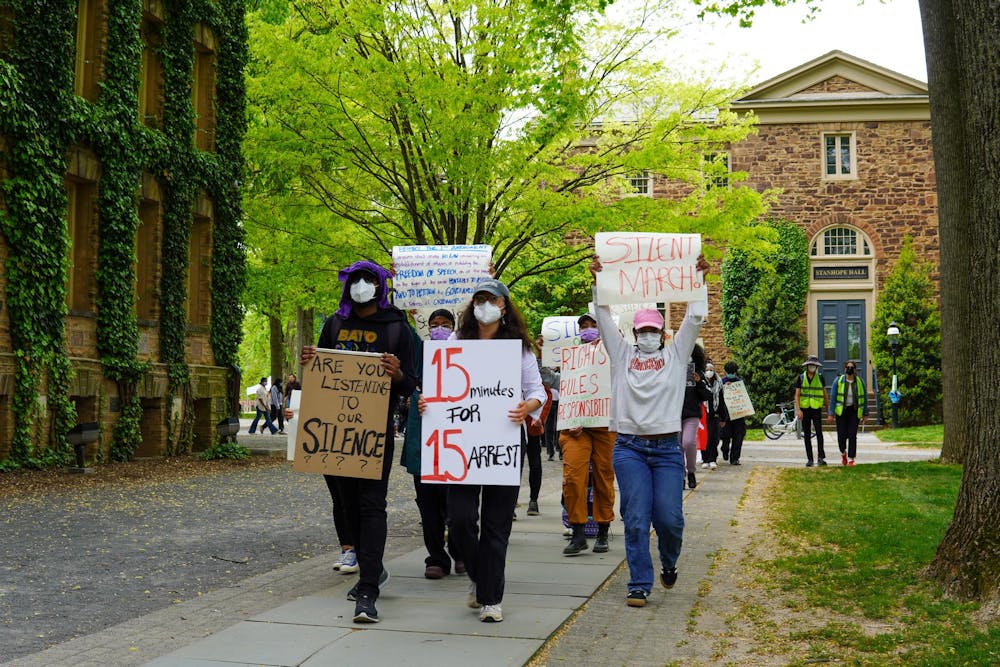On Tuesday, Aug. 27, Princeton University released a “Protests and Free Expression” website to serve as a hub for free speech guidelines on campus. The release of the website follows a heated end to the spring semester as Princeton’s “Gaza Solidarity Encampment” held demonstrations starting in late April, which led to the arrests of several students.
Following campus protests across the country, ranging from marches, rallies, and concluding with encampments in the spring, several universities have moved to restrict protests ahead of the semester. Princeton has made some changes, but much of the new website clarifies and condenses regulations that were once scattered across several University websites and departments.
According to University spokesperson Jennifer Morrill, the website was made as part of the University’s “commitment to transparency and to free and open inquiry in all matters.” The site “aims to increase awareness and understanding in the community about Princeton’s protest policies,” she wrote to The Daily Princetonian.
“It also serves an important reminder to community members about policies that apply to them,” she added.
Princeton’s approach to protests has centered around “time, place, and manner” regulations. Before the encampment began, University President Christopher Eisgruber ’83 published a letter in the ‘Prince’ highlighting the importance of enforcing rules and maintaining that they are “viewpoint-neutral and content-neutral.”
The ‘Prince’ examined the new guidelines to see how they will impact the future of free speech and protests on campus.
The new regulations explicitly prohibit protests and demonstrations on the lawn of Nassau Hall, on Cannon Green, and on Prospect House grounds. Notably, the “Gaza Solidarity Encampment” began in McCosh Courtyard, but moved to Cannon Green following the occupation of Clio Hall on April 29.
Prior to the “Gaza Solidarity Encampment,” the University’s Conferences and Events website stated that the three spaces “are reserved for University ceremonial events, most held annually, such as the fall Pre-rade, Communiversity [now known as Porchfest], Commencement, Class Day[,] and are not normally available for any other purpose.”

However, it did not state that their use is restricted for protest activities. This is a change in policy, as University-permitted protests on the lawn in front of Nassau Hall have occurred for years.
The walkway in front of Nassau Hall is listed in Rights, Rules, Responsibilities (RRR) as an area where protest is “generally permissible.” In an email to the ‘Prince,’ Morrill clarified that the walkways are the cement sidewalks outside of Nassau Hall — protests are not permitted on the lawn.
Another updated guideline explicitly bans camping or sleeping on campus. While the Office of the Dean of Undergraduate Students (ODUS) “Forms of Expression” webpage has long listed that camping is “generally prohibited” on campus, the FAQ section of the site now says, “Sleeping overnight in public or outdoor spaces of any kind is also prohibited.”
“The goal of this clarification and additional efforts to publicize policies is to ensure community members are clear about our policies, and to ensure they are consistently applied,” Morrill said.

Physical manifestations of that effort have cropped up on campus. New signs now surround the perimeter of Cannon Green warning against arranging protests in the space.
“This space is reserved for officially sanctioned University events and may not be used for other organized activities without permission. Informal recreation is permitted,” the signs read.
“Cannon Green may not be used for a protest or demonstration, even if impromptu,” Morrill added.
The Guidelines & Policies section specifically describes the manner of protestors, or how they choose to demonstrate, and restricts protestors from interrupting University proceedings.
Much of the rules are grounded in RRR 1.2.3, “Peaceful Dissent, Protests, and Demonstrations”: “It is a violation of these policies whenever any individual prevents, or willfully attempts to prevent, the orderly conduct of a University function or activity, such as lectures, meetings, interviews, ceremonies, and public events; or blocks, or willfully attempts to block, the legitimate activities of any person on the campus or in any University building or facility.”
The site describes these activities as disrupting the program or regular University operations, blocking entrances and exits, projecting lights or imagery, camping, sleeping or leaving unattended belongings outside overnight, and using amplified sound.
Policies listed on the website regarding a campus ban on chalk and tape, and rules surrounding marches, postering, and symbolic structures have existed prior to the “Gaza Solidarity Encampment.”
The prohibition of the use of chalk and tape on University grounds and walkways has been noted on the ODUS website prior to the “Gaza Solidarity Encampment,” as have policies limiting the locations of posters. Additionally, the stipulation that posters can be removed if someone complains and there is no contact information included on the poster has been included in RRR for multiple years.
Policies regarding discussing march routes with ODUS, getting approval from the Princeton municipality at least two weeks prior to organizing a march that will enter the town, and the mandate that symbolic structures get University approval prior to erection have historically existed within the ODUS “Forms of Expression” webpage.
While much of these policies have been included across several University resources, it is unclear whether the University will apply more scrutiny in the semester ahead. The first notable protest of the semester — the “Welcome Back to the Popular University” rally — is scheduled for Tuesday, Sept. 3 at 5 p.m. in McCosh Courtyard.
Olivia Sanchez is an associate News editor for the ‘Prince.’ She is from New Jersey and often covers the graduate school and academic departments.
Please send corrections to corrections[at]dailyprincetonian.com.








